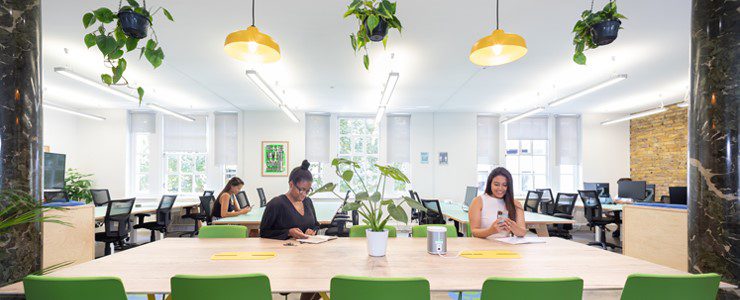Slippers in the office?
How would you feel if you went to a business meeting at a colleague’s office and found they were wearing slippers? Would you applaud their choice of workwear, or would you feel this looked unprofessional and inappropriate?
Surveys have revealed 70% of Brits dream of ditching formal wear for the office in favour of comfort, with 30% of office workers thinking the casual dress code should stretch to wearing slippers too. However, for others, slippers are a step too far and should be reserved for home confines.
The growing demand for more casual work attire stems from people working from home offices during the pandemic, according to a survey by footwear manufacturer Bedroom Athletics. People grew accustomed to sitting at their desk wearing jogging pants, t-shirt and slippers. After all, no-one could see their feet on a Zoom call!
Workers said feeling comfortable made them more productive. Some said they even wore their dressing gown for a quarter of their working day. Having returned to the office now, a lot of employees find their corporate clothing restrictive, and some even consider that it impacts their work.
Are slippers a step too far?
Some businesses encourage employees to dress comfortably – but is wearing slippers a step too far? Yes, according to 70% of office workers polled.
Some people who have noticed a colleague wearing slippers have admitted to feeling slightly irritated. They feel it makes the office seem like an “extended living room” and is inappropriate for a public workplace. Some respondents say wearing slippers at the office makes the wrong kind of statement.
Considering 28% of people working from home had put on a suit to take part in Zoom calls, it’s easy to see how these same people would be offended at too much casual clothing taking over the workplace.
Advantages of wearing slippers
Many workers rush around all day in shoes that make their feet ache in order to look smart. A real sense of freedom sets in when they arrive home and take them off. It becomes a kind of ritual: arrive home, remove the stiff leather shoes and put on your comfy slippers.
Why not bring this feeling to the office and be comfortable all day long? Supporters of slippers in the workplace say they should have the freedom to choose their own footwear.
Several studies have linked feeling comfortable to increased productivity. Research has revealed there’s an increase in productivity of up to 8.6% among employees who feel comfortable in their clothes. This may be one of the reasons why some workplaces are relaxing the dress code rules.
Disadvantages of slippers
If your employer hasn’t fully embraced more casual attire for the office, it may be because of concerns it looks unprofessional. Research by One Poll reveals 56% of employees feel their workplace isn’t open to more casual clothing.
Some employees say they like going to the office because of the requirement to dress up more. Wearing slippers would spoil the polished effect. Slippers remind them of hanging out in front of the television. Plenty of businesswomen going to work on the Tube are wearing suits with trainers but change into smart shoes on arriving at the office.
Studies also show a person dressed in business clothing is more successful at making a phone call than someone working from home in pyjamas. Psychologists say it’s all to do with how we perceive ourselves and our confidence levels.
Some employers feel staff who wear slippers send out a certain message, appearing less sharp than their business shoe-wearing colleagues. They seem to like feeling “cosy” – suggesting the way they work may be pretty “fuzzy” too.
What slippers are most acceptable?
If your office permits casual wear, some types of slippers are more acceptable than others. Most people would be unlikely to wear fluffy bunny slippers to work. However, wearing a pair of mules is more appropriate.
This backless style of slipper, worn by men and women, was more likely to be seen in the bedroom in years gone by. However, in recent years, people have been wearing them in public more often. A dark-coloured soft leather mule could be worn with a dark suit and still look smart.
A pair of moccasins can also blend in well with an outfit. Paired with slim-fitting trousers, they can create a smart, yet casual look: soft loafers can also have the feel of slippers but look smarter. They are usually made of leather or suede, with a variety of styles and colours on offer. Even Gucci makes loafers, so it would be hard for anyone to object to such a high-quality brand for the office.
Companies who embrace work slippers
The US tech company Rainforest QA encourages employees to wear slippers at its San Francisco headquarters. A shoe rack stands by the entrance, and everyone receives a pair of branded Rainforest slippers on their first day.
Employees say they like the statement this makes about reinventing the traditional workplace. As the average person spends eight hours a day at work, Rainforest bosses say they want everyone to be their “authentic self” at the office. They need a “comfortable and inclusive” environment to achieve this.
The company has a very casual atmosphere, and most staff tend to wear casual shoes, such as trainers and flip-flops. Around 30% wear slippers or walk round in their socks. Staff see it as a positive step that gives them the freedom to choose their preferred option.
Can you wear slippers in coworking spaces?
People operating from coworking spaces often have a more relaxed attitude to clothing. Many believe workplaces should allow people to wear what they want, including slippers and comfortable shoes. A lot of freelancers, entrepreneurs and small businesses use coworking spaces, so it’s generally up to them what they wear. You will even see staff barefoot in some places.
The idea of coworking spaces is to allow people flexible, comfortable workspaces, going right down to the shoes. The environment should help people to feel as comfortable there as they would working from home to relieve stress in the office.
Coworkers often wear casual clothing, such as jeans and t-shirts, so extending this to footwear isn’t unusual. The question of whether the casual trend should continue when meeting clients and contacts is something the individual company should decide.
While some feel it’s okay to wear slippers among colleagues, they may consider shoes to be a more professional image to portray to visitors.
© Pixel-Shot / Shutterstock.com



